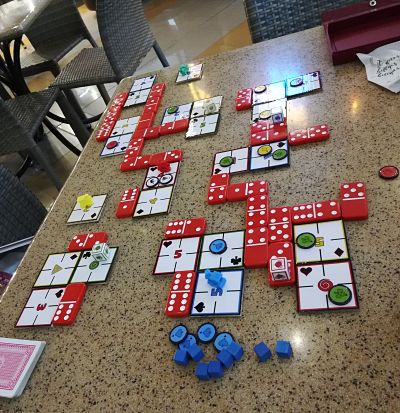![[Home]](https://ludism.org/logo/pplogo_sm.gif)
| Players | 2-4 |
| Length | 60-90 minutes |
| Equipment Required | 1 standard piecepack and 1 set of standard 2”x1” double-6 dominoes |
| Designer | StephenSchoessow and MichaelSchoessow |
| Version | 2.2 |
| Version Date | 2007-02 |
| License | custom license: "These rules may be freely copied and distributed provided the authors are credited or this header is left in place." |

Ship It! with house rules for two players (Daniel Ajoy, public domain)
The time is the late 1800’s. Big Industry is booming in America: railroading, mining, timber, and manufacturing. The players represent barons of industry, developing resources, building infrastructure, and shipping raw materials and goods for big profits. Players strive to transport the resources they control over the developing transportation networks they are helping to build, affecting markets to their advantage and beating out opponents with critical deliveries.
Players work to move their freight from its starting tile locations to one of the four shipment hubs. Then, when a major shipment occurs from one of these locations, all players who have freight warehoused there will make a profit. At the end of the game, the player who has reaped the highest profits wins.
http://www.ludism.org/ppwiki/download/Ship_It_22.pdf
The Group Projects piecepack game design contest seemed to attract a larger than normal number of big games among its entries, and Ship It! falls in that group. Set in the late industrial revolution, Ship It! is a pickup and deliver game with route building and blocking aspects. As such, it's related to many railroad games covering the same time period, especially those set in a relatively small, densely populated geographic area. Cities are randomly laid out at the beginning of the game, built from sets of tiles separated by gaps. Freight (non-null coins) are then distributed throughout the region. A set of double six dominos are transportation links that players can purchase, randomly draw from a face-down pool and then build to connect the cities. Piecepack dice are corrupt commerce officials that help their favorite teamsters while blocking shipments by other groups via an area control mechanism. Null coins and pawn saucers (or other suitable tokens) are used to monitor scoring on a simple score track included with the ruleset. The goal of the game is to ship your freight to distribution centers (tiles marked with pawns) in such a manner as to maximize your profits when freight from that center is distributed.
The Ship It! rules are generally well written, with only a few minor reservations. For example, there are several game-play examples and rules clarifications written right in the rules text (much like this self-referential example), which increases the paragraph lengths in some places, which in turn makes it difficult to refer back to the rules when a question comes up during play. The scoring track is also somewhat clunky in that it requires two suit-matched pieces in a ones digit plus tens digit system. But the included diagrams are clear and useful for explaining the examples. The use of bold and italics to emphasize certain points was also helpful, even though I sometimes found myself underlining additional passages for my own reference. The brief appendix is adequate, barely, but it is certainly not outstanding.
Mechanically, Ship It! is quite interesting. The economics of buying and building transportation links and moving commerce officials and freight is abstracted to an action point system in lieu of a money and income system. For Ship It! which is complicated enough as it is, this was a good design decision. Scoring can be tricky with all the potential bonuses. Occasionally, situations arise where there is a chain reaction of distributions and scoring, and these are usually a huge boon for the player who triggered the scoring. We thought the wild swings in points might break the game, but fortunately, since distribution centers are moved to the next higher tile after each shipment, scoring values increase over the course of the game, which builds tension and somewhat mitigates the chance of a runaway leader. These are unusually tight mechanics, and the authors should be commended on their play test efforts. The industrial revolution era teamsters theme has been used many times before, but there's a reason why it's so popular: it's a good theme. Ship It! felt a lot like Age of Steam set several decades later, which is a fairly high compliment regarding its fun factor. It certainly didn't feel like a two hour game.
One more thing I should highlight about Ship It! is that the three-player and four-player games are a lot different. In the three player game, anyone can move the freight from the extra suit, using it to trigger distribution at inopportune times or to cover high-valued half dominos to make shipping less expensive in certain areas. In the four-player game, the freight coins from each suit are exclusively controlled by only one player, and there is an additional commerce official in play. As a result, the three-player game is usually shorter and more vindictive, while the four-player game is more strategic and competitive. I prefer the four-player game. Seemingly as an afterthought, the authors tried to stretch Ship It! into a two-player game by having each player control two sets of pieces. This version is a bit of a hack, and Ship It! should really only be played with three or four players.
Conclusion: For a semi-abstract delivery game, Ship It! should appeal to serious rail gamers looking for something a bit lighter with which to pass a couple of hours. Ship It! should also appeal to German style gamers wanting to explore transport games without a huge time or money investment. Score: 25.28
Oct 19, 2004